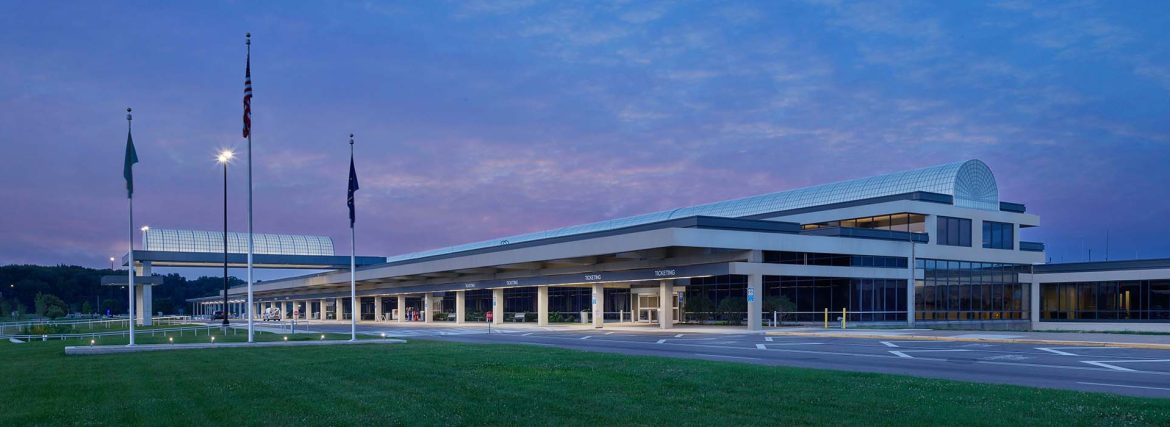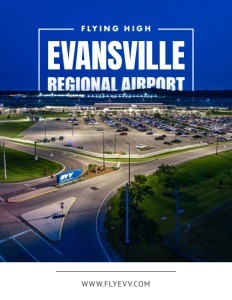Flying High
With pre pandemic aviation numbers, this airport is only looking upwards
When Nathaniel T. Hahn became Executive Director of Evansville Regional Airport in 2019, he inherited what he calls “the greatest year ever.” Then COVID struck. “The floor fell from under us,” Hahn recalls. Yet four years later, EVV is a recovery success story that many regional airports would envy. A Purdue University aviation administration graduate who earned his MBA and recently achieved A.A.E. accreditation from the American Association of Airport Executives—the industry’s highest professional credential—Hahn joined EVV as director of operations and maintenance in 2011 after working in airport operations at Midland International Airport in Texas.
The airport is approaching its 2019 record of 242,000 annual enplanements. “We’re on track to be at about 215, maybe 220,000 enplanements this year,” Hahn says. The recovery centers on strategic airline partnerships that expanded significantly in 2024. “Having three airline announcements in a single year is pretty significant. It’s even more significant for an airport our size,” Hahn explains.
American Airlines maintains service to Dallas and Charlotte, while Delta connects passengers to Atlanta. Chicago service returned in September 2024 through American Airlines after United’s 2021 departure. Allegiant operates seasonal flights to Orlando Sanford, Destin, and St. Pete Clearwater. Most notably, EVV became Indiana’s first airport to secure Breeze Airways, which launched service to Orlando International in February 2024 with 120-seat Embraer E-190 aircraft.
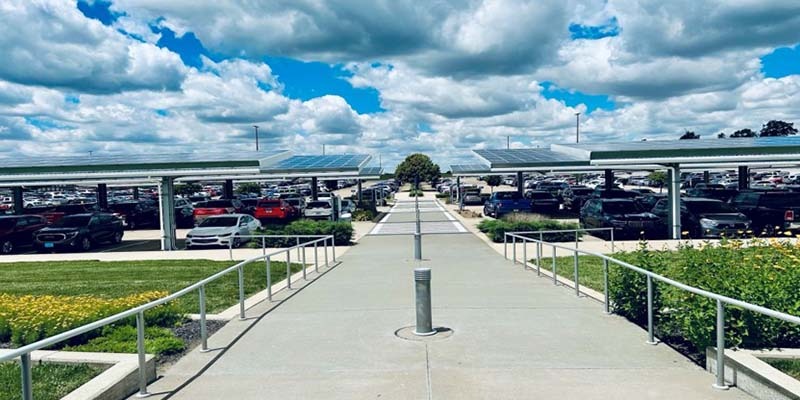 Building for Tomorrow through Strategic Infrastructure
Building for Tomorrow through Strategic Infrastructure
Hahn’s planning philosophy centers on enabling future growth through current projects. “What you want to do is create a plan, then work the plan,” he explains. “Too many times we think we know what it takes to get to the outcome we want, and then we get distracted with everything else.” This approach shaped three major infrastructure completions in 2024.
The airport’s new 43,000-square-foot maintenance facility is a transformational upgrade. “We were actually limited in the size of equipment we could use on the airfield because we couldn’t fit it in our old building. It was so old and so small,” Hahn says. “Now we can literally double the size of some of our equipment, so for winter operations and snow removal operations, we’re a lot more efficient as we continue to upgrade our equipment.”
EVV also expanded its parking capacity by 200 spaces, but Hahn designed the project with future needs in mind. “We didn’t just expand the parking lot. When we expanded it, we built it such that yes, we added 200 spaces but designed it so that 200 more spaces are ready to go already,” he explains. The expansion incorporated infrastructure for extending the airport’s successful solar-covered parking, currently the largest array of its kind in the Midwest, generating 1.3 megawatts of power. The covered lot transformed from 20-30 percent utilization to over 90 percent capacity.
A planned $8-12 million baggage handling system replacement is EVV’s next major infrastructure investment. “That’s a really big project for us,” Hahn acknowledges, noting the scale relative to the airport’s size.
Launching the New GA Terminal
The centerpiece of EVV’s corporate aviation expansion is a new general aviation terminal that more than doubles the previous facility’s capacity. Built in partnership with United Companies Air Center, the facility serves the airport’s 70-80 based aircraft, which range from large corporate hangars to personally owned planes. “We went from a 4,500-square-foot building to a 10,000-square-foot state-of-the-art facility,” Hahn says.
The terminal’s design specifically targets business development and site selection activities. “If you’re a business and you’re coming in to complete a deal, or quite honestly, if you’re just coming in and doing site selection, you can fly over your site, land, walk out of your plane, walk into this beautiful building, walk into a conference room with our economic development team, work through anything,” Hahn explains. “You never really have to leave the airport, and you can complete that deal.”
Corporate aviation represents roughly one-third of EVV’s general aviation traffic, with small corporate aircraft making up a significant portion, alongside personally owned airplanes. The new facility anchors broader West Ramp development plans to cater to maintenance, repair, and operations. “We’re working on a design that would create new roadways and new access for future hangar development,” Hahn says. “We’ll have space for large hangars, not just 100-by-100 hangars, but even larger than that if needed.”
The investment aligns with EVV’s role as the “front door to our community,” as Hahn describes it. When site selectors arrive to evaluate multimillion-dollar investments, the airport wants them to experience superior customer service and a progressive facility that characterizes the region’s business-friendly environment.
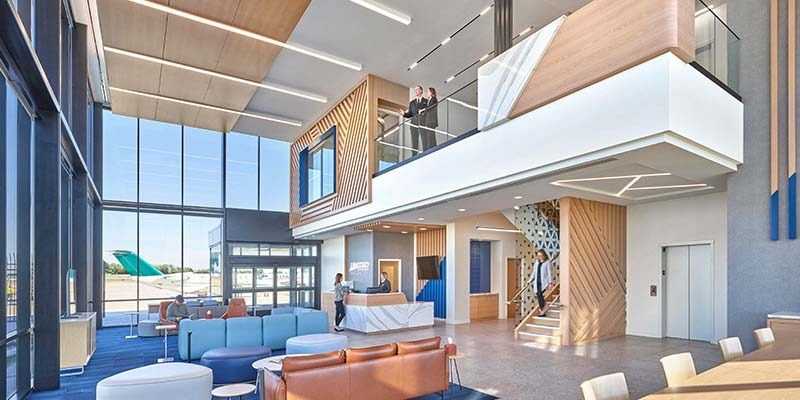 Economic Impact as a Regional Business Engine
Economic Impact as a Regional Business Engine
EVV generates over $200 million annually in economic impact, according to Hahn, making it a critical infrastructure component for regional business development. The airport sits on the Evansville Regional Economic Partnership Board, actively participating in strategies to attract and retain businesses. “We view ourselves as an economic engine for the region,” Hahn says. “What are we doing so that every single time someone lands here, they see the Hoosier hospitality, but they also see us as a value to their business?”
Toyota Motor Manufacturing Indiana typifies this economic connectivity. Located 25 miles north in Princeton, the facility employs over 7,000 people and is the largest manufacturing investment in the region with over $8 billion committed since 1996. “Toyota has one of the largest manufacturing plants in the United States, just north of us, and literally just doubled its size over the last few years,” Hahn explains. “Our air service connection to Dallas, which is where their headquarters is, is key to that plant’s success. Our corporate side of things, when they need to fly corporate travelers in, the fact that we now have a beautiful new terminal makes all the difference.”
Non-aeronautical development also contributes to EVV’s economic footprint. Developer Jack Rogers has constructed three warehouse facilities totaling 1.3 million square feet on airport property, with the newest 300,000-square-foot building leased by Aramco. However, geographic constraints limit future expansion. “We are uniquely landlocked,” Hahn notes. “I’ve got a railroad to my east, I’ve got a state highway to my north and to my west, and there’s a massive 3 million square foot warehousing and manufacturing operation south of us.” This reality focuses development efforts on aeronautical businesses where EVV maintains competitive advantages.
Next Generation Aviation Workforce Development
Hahn’s passion for developing aviation careers isn’t just about EVV’s operations. As president of Indiana’s state aviation association, he spearheads efforts to introduce aviation education at the high school and middle school levels across the state. “One of our goals is to try to figure out how best to grow aviation because it’s a wonderful job,” he says. “We need mechanics, and we need pilots.”
The workforce challenge requires broad thinking about aviation careers. “The line I always use is: I don’t care what you want to do in the world, we need it in the aviation world,” Hahn explains. “If you love numbers and finance, I need a finance director. If you love planning or you like building things, we need engineers and we need construction.” He describes airports as microcosms requiring diverse skills from fire and law enforcement to utilities and roads management.
Locally, Hahn collaborates with Evansville’s school corporation to launch an aviation program focused on aircraft repair and maintenance. The initiative builds on Indiana’s existing aviation education infrastructure, which includes programs at Purdue University, Indiana State University, the University of Southern Indiana, and Ivy Tech Community College. Excel Aviation operates a flight school at EVV, adding to the state’s pilot training capacity.
Hahn’s personal professional development exemplifies his philosophy. He recently earned his MBA and achieved A.A.E. accreditation from the American Association of Airport Executives, the industry’s highest credential. “I love looking at how we develop the next generation of aviation leaders,” he says. “How do we get people to look at their careers? I want them to be ready, and I want them to be better than me.”
Tourism and Community Connection
EVV’s tourism strategy focuses on enhancing quality of life for residents while attracting visitors through unique historical assets and convenient travel options. “If you’ve got little kids and you want to grow up in a small city or a big town, Evansville is perfect for that,” Hahn says. “We have good schools and all those types of things. And if you want to grow a family and you still want to go to Disney, we make that a one-stop shop.”
The airport partners with Visit Evansville to support regional tourism initiatives, though Hahn notes their approaches vary depending on target markets. “At times they’re seeking more regional based conferences and events. That’s a different approach than if you’re looking at pure tourism,” he explains. EVV’s direct flights to Orlando through both Breeze and Allegiant provide families with accessible vacation options without connecting flights.
The Evansville Wartime Museum, housed in one of EVV’s hangars, is as a major historical attraction showcasing the region’s World War II manufacturing legacy. During the war, Evansville’s Republic Aviation produced over 6,000 P-47 Thunderbolt fighter aircraft, earning three military awards for excellence and a visit from President Franklin Roosevelt. The museum displays “Hoosier Spirit II,” a restored P-47 that was designated Indiana’s official state aircraft in 2021.
Beyond aviation history, the region offers diverse recreational opportunities. “We have casinos, and we have valleys here,” Hahn notes, referring to general tourist draws. The nearby Hoosier National Forest to the east and Shawnee National Forest to the west provide hiking opportunities. “I would not describe Evansville itself as great hiking, but near hiking from a flatter Midwestern perspective. It’s not Colorado hiking,” Hahn clarifies, managing expectations while highlighting accessible outdoor recreation options.
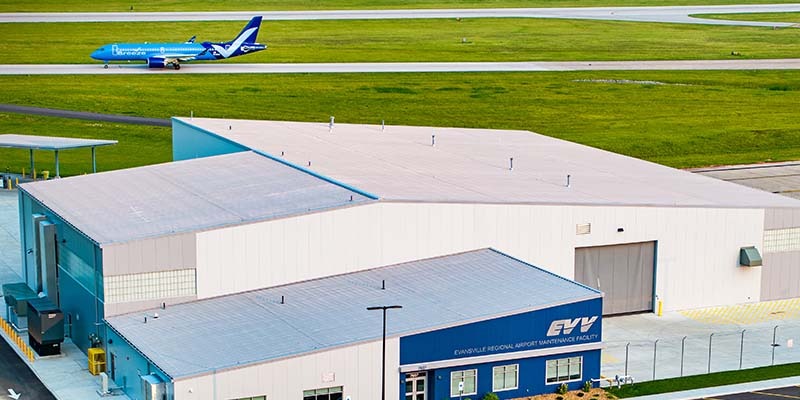 Infrastructure and Community Partnership
Infrastructure and Community Partnership
Hahn acknowledges that 2024’s ambitious expansion creates space for more methodical development in 2025. “I joke, and it is only a joke that I tell the team, we did so much last year, we’re just going to take 2025 off,” he says. However, the airport’s upcoming projects focus on essential infrastructure that enables future growth rather than headline-grabbing expansions.
The next 18 months include runway rehabilitation for EVV’s secondary runway 18/36, taxiway reconstruction, and the major baggage handling system replacement. “Airports typically go through periods where they’re doing the big exciting flamboyant things, air service, new buildings, and then you do have to take a step back and rebuild your infrastructure and prepare for that next big push,” Hahn explains. West Ramp infrastructure improvements will include relocating taxiways and roadways to safer configurations while preparing for expanded corporate aviation development.
Air service development remains a constant priority, with Hahn emphasizing community responsibility for the airport’s growth. “It doesn’t matter how many airlines I talk to, if our community chooses to fly out of other airports, those airports will grow and EVV will not,” he says. The airport’s “Fly EVV First” campaign asks regional residents to support local service to justify additional routes and frequencies. “Every time we go up a couple percent, that means an aircraft for our community. And when you’re an airport the size of ours that only has 10 flights to five, six, seven destinations, every flight matters.”
EVV’s recovery from pandemic lows to near-record passenger levels is a compelling story of how strategic planning, infrastructure investment, and community engagement can position regional airports for sustainable growth. Under Hahn’s leadership, the facility balances immediate operational needs with long-term vision, creating a foundation for continued expansion in Indiana’s competitive aviation market.
AT A GLANCE
Name: Evansville Regional Airport (EVV)
What: Commercial and general aviation facility with three runways spanning 1,250 acres, serving as Indiana’s fourth-largest airport with nearly 500,000 total annual passengers
Where: Evansville, Indiana
Website: https://flyevv.com/
PREFERRED VENDORS
Explore Evansville serves as the official tourism organization for Evansville and Vanderburgh County dedicated to market and support the local hotels and attractions by developing and facilitating the convention and visitor industry in Evansville, Indiana.
Evansville Convention and Visitors Bureau – www.exploreevansville.com
